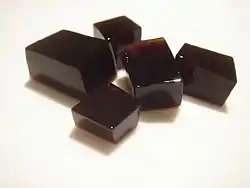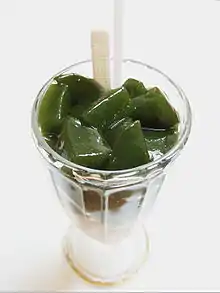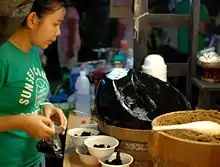Grass jelly
Grass jelly, or leaf jelly or herb jelly, is a jelly-like dessert eaten in East and Southeast Asia. It is created by using the Platostoma palustre plant (a member of the mint family) and has a mild, slightly bitter taste. It is served chilled, with other toppings such as fruit, or in bubble tea or other drinks. Outside Asia, it is sold in Asian supermarkets.
 Pieces of grass jelly cut into ~1 cm cubes | |
| Alternative names | Leaf jelly, Cincau |
|---|---|
| Course | Dessert |
| Region or state | East Asia and Southeast Asia |
| Serving temperature | chilled or hot |
| Main ingredients | Platostoma palustre (Mesona chinensis) stalks and leaves, potassium carbonate, starch |
| Grass jelly | |||||||||||||||||||
|---|---|---|---|---|---|---|---|---|---|---|---|---|---|---|---|---|---|---|---|
| Chinese name | |||||||||||||||||||
| Chinese | 仙草 | ||||||||||||||||||
| |||||||||||||||||||
| Vietnamese name | |||||||||||||||||||
| Vietnamese | sương sáo | ||||||||||||||||||
| Thai name | |||||||||||||||||||
| Thai | เฉาก๊วย | ||||||||||||||||||
| RTGS | chaokuai | ||||||||||||||||||
Nutritional value
Containing carbohydrates 44 g. per 330 g. of grass jelly and 2 g. of these carbohydrates are from dietary fiber, and also contains 2 g. of protein. Moreover, grass jelly does not have any fat, vitamins or minerals.
Preparation
Grass jelly is made by boiling the aged and slightly oxidized stalks and leaves of Platostoma palustre (Mesona chinensis)[1][2] with potassium carbonate for several hours with a little starch and then cooling the liquid to a jelly-like consistency.[1][3] This jelly can be cut into cubes or other forms, and then mixed with syrup to produce a drink or dessert thought to have cooling (yin) properties, which makes it typically consumed during hot weather. The jelly itself is fragrant, with a smoky undertone,[4] and is a translucent dark brown, sometimes perceived to be black. Food coloring may sometimes be added to make it darker.
Some other variants of grass jelly, known as green grass jelly, don't require cooking or heating process to make, only requiring a mixture of leaf extracts and water. Jelly produced in this way has been described as having a leafy neutral or plain flavor.[5]
Regional
Mainland China, Hong Kong and Macau
In Mainland China, Hong Kong and Macau, grass jelly was traditionally served with sugar syrup. Now it is often served mixed with other ingredients, such as mango, sago, watermelon, cantaloupe, and other fresh or canned fruit, and condensed or evaporated milk.
Although this dish is sometimes called liangfen (leung fan) in Chinese, it should not be confused with the Chinese starch jelly liangfen, which is an entirely different dish.
Indonesia


Grass jelly is known as cincau in Indonesian (it means green grass in Chinese). It is also known as camcao, juju, janggelan or kepleng in Java, camcauh in Sunda, and daluman in Bali. Black jelly (cincau hitam) is manufactured as an instant powder, like other instant jellies or agar. This form is easier to use. It is made from the leaves of Platostoma palustre (Mesona palustris).
There are other plants that were used in Indonesia to make grass jelly. They are Melastoma polyanthum, known as cincau perdu,[6] and Cyclea barbata, known as cincau hijau or green grass jelly,[7] and Cocculus orbiculatus or known as cincau Cina or Chinese green grass jelly.[8] Some plants from genus Stephania such as Stephania hernandifolia (also known as Stephania japonica) and Stephania capitata are also being used as a substitute to create green grass jelly called cincau minyak or oily grass jelly.[8]
Usually, the process of making Indonesian green grass jelly doesn't require a cooking or heating process. Mixing leaf extract and water with the addition of a period of waiting time for coagulation at mild room temperature is enough.
Indonesian green grass jelly has a distinct flavor compared to black grass jelly. It is absent of smoky flavor, almost no bitter taste, and has a mild leafy flavor. Due to its plain neutral flavor, it is usually consumed with sugar water, syrup, coconut milk, and ice.
Malaysia, Singapore and Brunei
Plain grass jelly is mixed in various kinds of desserts, such as ais kacang and cendol. It is also mixed with cold soy milk and served as a refreshing drink/dessert, a drink known as Michael Jackson in South-East Asia (a reference to Michael Jackson's changing skin color and/or the song "Black or White").[9] Various combinations of grass jelly with rose flavoured syrup added to milk (bandung) are called "bandung cincau" or "bancau" for short. There is also shaved ice with grass jelly toppings. It can be green or brown.
Philippines
Grass jelly (Philippine: gulaman) bricks are used in the various Philippine refreshments or desserts such as sago’t gulaman, buko-pandan, agar flan or halo-halo. It may also be used in fruit salads.
Taiwan
In Taiwan, grass jelly is known as 仙草 (xian cao), and is used in various desserts and drinks. It can sometimes be added to boba drinks and shaved ice (刨冰). It is also commonly used in a traditional Taiwanese drink, where the jelly is heated and melted to be consumed as a thick dessert beverage (仙草茶), with numerous toppings like tangyuan, taro balls, azuki beans, and tapioca.
Thailand
In Thailand, grass jelly is known as chaokuai (Thai: เฉาก๊วย, pronounced [t͡ɕʰǎw.kúa̯j]) like the Teochew (from Hokkien Chinese: 草果; pinyin: cǎoguǒ). It is commonly served relatively plain together with ice and natural brown sugar. Additionally, it can also be served with fruits such as jackfruit, the fruit of the toddy palm or mixed with other Thai desserts.
Vietnam
In Vietnamese, grass jelly is sương sáo or thạch sương sáo. Grass jelly is chopped in small cubes and served as an additional ingredient in sweet desserts made from various kinds of beans (chè). There are two common kinds of grass jelly in Vietnam which are Platostoma palustre (Mesona chinensis, called sương sáo in Vietnamese) and Tiliacora triandra (called sương sâm; sương sa or rau câu is the name for jelly made from various kinds of algae). It is common now to eat green grass jelly (thạch lá găng) with douhua (tào phớ) and grass jelly (sương sáo or thạch đen) in the summer.
See also
| Wikimedia Commons has media related to Grass jelly. |
References
- 仙草 (in Chinese). 台北市內雙溪森林藥用植物園編輯組. Archived from the original on 2012-03-21.
本品加水與少許鹹共同煎汁,添加少許澱粉漿可製成仙草凍,是夏天常吃的清涼飲品
- Armstrong, Wayne P. "Grass Jelly (Mesona chinensis)". Retrieved 2008-05-19.
- Bush, Austin. "Inside the greenhouse". Archived from the original on 2008-05-26. Retrieved 2008-05-19.
- Wei, Clarissa (2016-05-31). "Sweet, Black Grass Jelly Shouldn't Come Out of a Can". Retrieved 2016-10-11 – via munchies.vice.com.
- Septiawan, Yunus (2016). Kajian Perbandingan Daun Cincau Hijau (Cyclea barbata L. Miers) dengan Air dan Konsenterasi Serbuk Stevia (Stevia rebaudiana Bertoni) Terhadap Karakteristik Gel Cincau Hijau (PDF) (BSc) (in Indonesian). Universitas Pasundan Bandung.
- "Melastoma malabathricum L." www.unimainz.de. Archived from the original on 18 December 2014.
- "Tanaman Obat Indonesia". www.iptek.net.id. Archived from the original on 2006-10-13. Retrieved 11 January 2012.
- Mursafitri, Eka Budi; Kriswiyanti, Eniek; Sutara, Pande Ketut (2016). "Kinship Analysis of Grass Jelly in Regency of Gianyar, Tabanan and Badung Based on Morphological and Anatomical Characteristic". Jurnal Biologi Udayana (in Indonesian). 20 (2): 59. doi:10.24843/JBIOUNUD.2016.v20.i02.p03.
- "Kopi (Coffee)". unclelimscafe.com. Archived from the original on 15 March 2008. Retrieved 11 January 2012.
- Adams, Allison (2015-04-28). "Fact About Grass Jelly". LIVESTRONG.COM. Leaf Group. Archived from the original on 2017-08-31.
